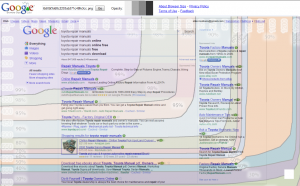In all the banter and confusion about the positives and negatives about Google Instant, there is at least one common thread that is good for the SEO industry itself: Snake Oil SEO won’t cut it in this new world.
Delivering traffic via the instant interface is going to be more challenging, whether you are working in the organic or paid search industry. In my opinion, the top SEOs have been on this course for a long time – this is nothing new. Universal SERPs, personalized SERPs and Google Suggest have sent thoughtful Search Marketers down the very path that we see here – starting as far back as 2006. But now, these changes are in your face.
Long Tail Ranking as a Sales Tool is Dead
I have caught snake oil SEOs selling services on the ranking performance for 3-4 word search phrases (aka “long tail”) and impressing the dickens out of clients. If you could rank a client for “blue bike chain jewelry” you must be one rockin’ SEO. Of course, even with these supposedly great rankings, traffic never showed, let alone conversions. You must rank for phrases that get traffic – but more importantly, buyers! (Postscript: Andy Beal makes an interesting point about how this actually helps long-tail SEO that is worth considering. I’m still banking on the laziness of users who will click on the very first thing they see and then navigate the SERPs. I think this pattern is TBD – but if users do start doing type-speed trial and error, a whole new realm of “variation SEO” could emerge.)
Clustering of Keywords Means Higher Competition
Google Instant is going to divert much traffic to phrases in the suggestion box. That means, quite simply, that the SERPs that go along with each instant-suggested phrase are going to be uber-important from here on. Users are lazy by nature, so they will be choosing those suggested phrases on a regular basis. If you can’t rank for those, you lose. This has clipped the long tail and will cause more competition for broader phrases. In addition, this whole mess pushes down the top organic ranking phrases into a teeny area at the bottom.
SEO-Friendly Site Architecture Just Became Even More Important
The design of your website from the home page to the category/hub pages to the individual content pages now represents an even more important part of ranking. The silos of your website and how you use tags and categories in blogs must correlate well with the Google Instant suggestions and the internal page rank must flow properly. This is not the realm of most snake oil SEOs.
Google Instant Raised the Importance of Non-Technical Aspects of SEO
One of the hardest parts of SEO is in the transformation of a poorly constructed (or new) website into a solid bank of crawler-friendly, user-friendly and link-worthy content – all while keeping the client happy. This requires management, leadership and creative thinking beyond what most “take the dollar and run” SEOs tend to offer. If you cannot successful help a client to step up to the plate and produce content to align with the shorter/mid tail keywords, you will not rank. This requires foresight and maturity to plan the project and to be sure everyone works together.
In Conclusion
I don’t necessarily like the Google Instant feature – from a UI standpoint it feels noisy. But I think it’s here to stay because it lets users be lazy and do searches faster. It requires less second-searches to refine queries and generally helps amateur searchers do a better job of finding what they want.
Photo by Rune Mathisen used under (cc) License









From what I understand the suggested phrases for Google suggestions are determined on a regional/local basis. I assume this will also be the case for Google Instant.
Yes, the same local/personalized ranking influences will affect the instant list… same as it has affected in Google Suggest. In my last post on Google Instant and SEO this was my first point – regional sites may see more traffic in “regional silos.” I think that the regional “relief valve” may indeed affect the long-tail clipping issue. So you may be right for these types of sites. It could be that regional sites need to do a better job on their regional linkbuilding (exceedingly rare that this is done well) and content creation to ensure they are ranked when regional suggestions are shown. Thanks for your thinking on this. I am looking forward to seeing how this pans out.